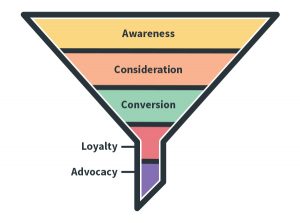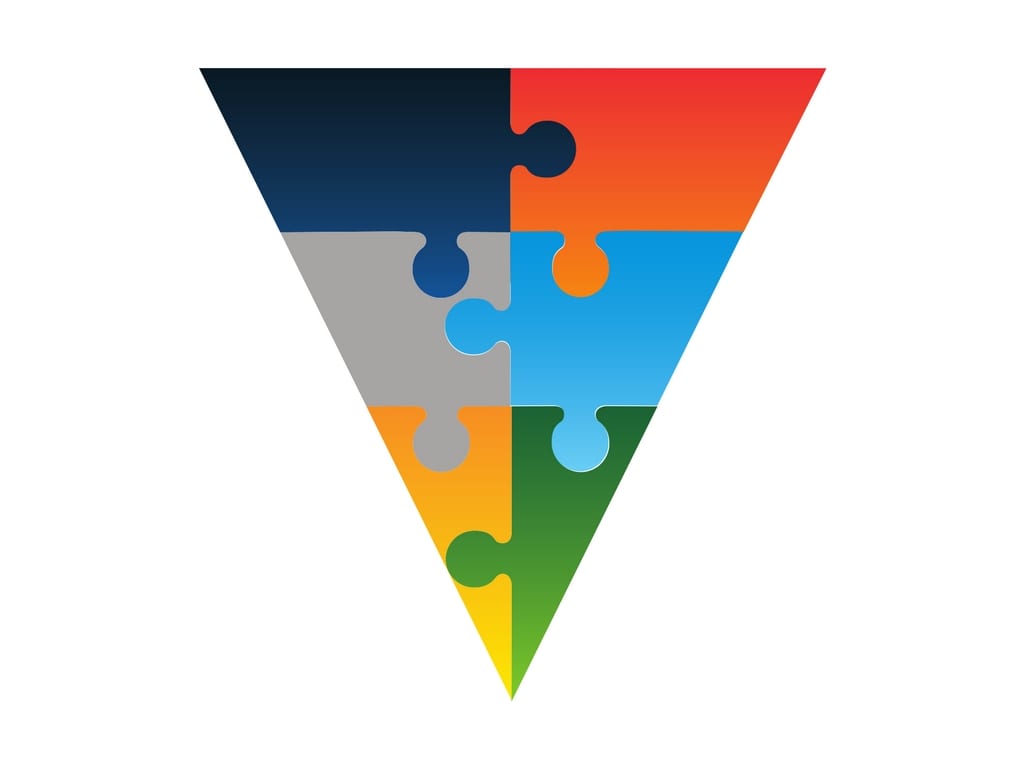Ask any other fellow marketer and they will probably agree that writing a marketing strategy is no easy task.
A good marketing strategy will map out an end to end plan that illustrates the full customer’s journey.
This means including attracting visitors when they are strangers to your brand, all the way through to them becoming a paying customer.
With so many touch points through the various stages, and with each customer’s journey being different, it can be hard to know where to even start.
However, there is a tool that marketers can use that will make this task easier. Hands up who is familiar with the marketing funnel?
For those who need a little reminder, the marketing funnel is an awesome tool that helps marketers have a better and clearer picture of the customer’s journey:

This image represents the journey a customer takes from first hearing about a company, or brand, to conversion (and hopefully beyond to them becoming an advocate of your brand).
An overview of the marketing funnel
The marketing funnel has five stages:
- Awareness
- Consideration
- Conversion
- Loyalty
- Advocacy
When picturing a funnel it starts wide at the top and gets narrower and narrower as you reach the bottom. Size doesn’t mean anything.
Just because awareness is at the top of the funnel it doesn’t mean that it’s more important than loyalty or advocacy, which is found at the bottom. Each stage is as important as the other stages.
Profitability is in growing accounts through upselling
Many businesses and brands fall into the trap of believing that generating new leads is the most important thing to do and often neglect those who are already customers.
What if we told you that it’s eight times cheaper to upsell to an existing customer then it is to acquire a new customer?
Also, according to Nielsen, 84% of people trust recommendations from friends and family compared with marketing campaigns. This makes personal referrals one of the highest ranked sources for trustworthiness when it comes to buying a product or service.
Nurture your existing customers so that they become loyal, and hopefully one day they will even become an advocate of your brand or company, helping you with sales!
To ensure that customers are receiving the best possible service some marketers have decided to ignore the traditional cone shaped funnel and have adopted a new design that looks like a bow (wide on the left and right and narrow in the middle).
The marketing funnel stages in depth
Now that we have reminded you about the stages we’ll move on to looking at each stage and provide examples of how you can use direct mail.
Awareness – at this stage prospects are strangers. They don’t know anything about who you are or what you do. We need to educate them and this is a great opportunity to start to build a trusting relationship. It is too soon to try and sell so put away sales materials, instead send something that will be helpful.
Direct marketing campaigns are great for educating prospects and building awareness of what your brand does.
Let’s say, for example, you are a dentist. You could send out a printed postcard with your top five tips for oral hygiene. Perhaps you are personal trainer?
You could send out a ‘how to live a healthier life’ booklet with advice and tips ranging from your best exercises to healthy recipe ideas.
Consideration – after awareness the prospect then moves into the consideration stage of the funnel. Here the prospect is willing to consider your services or products. Here we want to build a deeper relationship and again stay away from being too salesy.
At the consideration stage direct marketing can help create content that is helpful and product specific. This is where case studies would go down a treat; so too could providing a taste of what you can offer.
For example, a hairdresser could send out before and after photos of hair transformations they have done.
You could go very swanky. A solicitor’s firm could send out a video book that shows a portfolio of clients and what they have achieved for them.
Conversion – whilst we can be salesy we don’t want to overwhelm at this stage. We want to convince a prospect to buy by showing them the benefits of your product or service.
Being personal is essential. We want to make the customer feel as if they are truly valued. An example of how this can be achieved through direct mail is handwritten invites to an exclusive event your company is hosting.
During this event the prospect will get a taste of what it is like to be a customer and, if they are impressed, they will hopefully want to sign up there and then.
Loyalty – here we want to delight and retain customers. Don’t ever stop interacting with them and always look for ways to add value.
There are many ways to delight and retain customers through direct mail. After identifying who your loyal customers are send them exclusive content through the post that makes them feel special.
For example, a loyal customer of a gin club could receive a bonus gin sample with a special cocktail recipe.
Advocacy – we want to turn loyal customers into fans and advocates who will refer your brand or company to their friends and family. At this stage keep delighting, and don’t be afraid to ask for feedback.
Turning loyal customers into fans can be easily achieved through direct mail. Who doesn’t love receiving something personal to them through the post?
Find out which customers love you and praise them. Maybe you are introducing a new product. Why not send a sample to your loyal customers and ask for their feedback?
Make sure you take on board their feedback and, when necessary, give credit to the customer when promoting it if you have taken on board their idea.
Go a step further and give five of their friends and family (including them) a discount on the product.
We hope you have found it useful and are now armed with ideas of what tactics you can deploy at each stage of the marketing funnel.
[optin-monster-shortcode id=”nhxraztiuybab8gzsadt”]
Back to case studies


